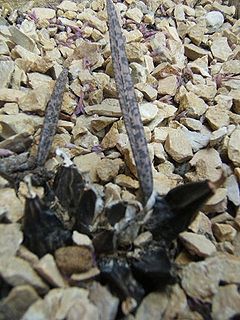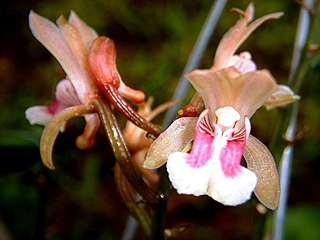
Oeceoclades decaryana is a terrestrial orchid species of the genus Oeceoclades that is native throughout southern and southeastern Africa. It can be found growing in Kenya, Mozambique, Zimbabwe, Madagascar, and KwaZulu-Natal in South Africa. It was first described by the French botanist Joseph Marie Henry Alfred Perrier de la Bâthie in 1935 as a species in the genus Eulophia. He later transferred this species to the genus Lissochilus in 1941, followed by another transfer to the genus Eulophidium in 1957 by the English botanist V.S. Summerhayes in 1957. When Leslie Andrew Garay and Peter Taylor revised the genus Oeceoclades in 1976, they transferred this species to the expanded Oeceoclades.

Eulophila pulchra, commonly known as the gonzo orchid, is a plant in the orchid family and is native to areas from Tanzania and Mozambique to the Western Pacific Ocean. It is a terrestrial orchid with crowded, above-ground pseudobulbs, two or three leaves and pale yellowish green flowers with dull purple or red markings. It grows in plant litter in rainforests.

Jean Marie Bosser, sometimes listed as Jean-Michel Bosser was a French botanist and agricultural engineer who worked extensively in Madagascar and Mauritius.
Oeceoclades calcarata is a terrestrial orchid species in the genus Oeceoclades that is endemic to Madagascar. It was first described by the British botanist Robert Allen Rolfe in 1905 as Eulophia paniculata. The German botanist Rudolf Schlechter later described this species as Cymbidium calcaratum in 1915 and then transferred his own taxon to the genus Eulophia in 1925. When Leslie Andrew Garay and Peter Taylor revised the genus Oeceoclades in 1976, they transferred this species to the expanded Oeceoclades as O. calcarata because even though Eulophia paniculata was the older name and thus had priority, there had already been an earlier species named Oeceoclades paniculata that prevented using that specific epithet.
Oeceoclades cordylinophylla is a terrestrial orchid species in the genus Oeceoclades that is native to Comoros and northern Madagascar. It was first described by the German botanist Heinrich Gustav Reichenbach in 1885 as Eulophia cordylinophylla. It was first transferred to the genus Lissochilus by Joseph Marie Henry Alfred Perrier de la Bâthie in 1941, then to the genus Eulophidium by V.S. Summerhayes in 1957, and later to the genus Oeceoclades in 1976 by Leslie Andrew Garay and Peter Taylor. The type specimen was collected from the Comoro Islands by Léon Humblot, but the actual specimen is missing. Garay and Taylor indicated that an herbarium sheet of Humblot's with an unpublished name by Reichenbach appears to align well with the original description. The margins of the column wings of O. cordylinophylla are ciliolate-hirsute, fringed with stiff, minute hairs.
Oeceoclades lanceata is a terrestrial orchid species in the genus Oeceoclades that is endemic to central Madagascar. The flowers are rose-colored. It was first described by the French botanist Joseph Marie Henry Alfred Perrier de la Bâthie in 1935 as Eulophia lanceata. Perrier then later reduced the species to a synonym of Eulophia pandurata. The species was resurrected and transferred to the genus Oeceoclades in 1976 by Leslie Andrew Garay and Peter Taylor, who argued that O. lanceata and O. pandurata are distinct with regard to their floral structure and shape of the labellum. Garay and Taylor noted that O. lanceata is similar in vegetative morphology to O. seychellarum.
Oeceoclades lubbersiana is a terrestrial orchid species in the genus Oeceoclades that is native to the Democratic Republic of the Congo and Uganda. It was first described by the Belgian botanists Émile Auguste Joseph De Wildeman and Émile Laurent in 1899 as Eulophia lubbersiana, then moved to the genus Eulophidium by V.S. Summerhayes in 1957 and again transferred to the genus Oeceoclades in 1976 by Leslie Andrew Garay and Peter Taylor. Garay and Taylor noted that this species is similar to O. atrovirens in vegetative morphology, but is better allied to O. latifolia and O. pandurata because all three possess a labellum that is wider than it is long. Oeceoclades lubbersiana was named in honor of Louis Lubbers, who was a botanist working at the Botanical Garden of Brussels.
Oeceoclades pandurata is a terrestrial and epiphytic orchid species in the genus Oeceoclades that is native to eastern Zimbabwe and Madagascar. It was first described by the British botanist Robert Allen Rolfe in 1891 as Eulophia pandurata, then moved to the genus Lissochilus by Joseph Marie Henry Alfred Perrier de la Bâthie in 1941, and again moved to the genus Eulophidium by V.S. Summerhayes in 1957. It was finally transferred to the genus Oeceoclades in 1976 by Leslie Andrew Garay and Peter Taylor. Garay and Taylor noted that this species possesses lateral veins on the labellum that fringed with small hairs. Oeceoclades pandurata is distinguishable from other species in the genus by the lateral lobes of the labellum, which are free and truncate. The type specimen was collected on trees near Fort Dauphin on Madagascar, now known as the city of Tôlanaro. The specific epithet pandurata refers to the fiddle-shaped labellum.
Oeceoclades perrieri is a terrestrial orchid species in the genus Oeceoclades that is native to Mozambique and northwestern Madagascar. It was first described by the German botanist Rudolf Schlechter in 1913 as Eulophia ambongensis. Schlechter had also described a separate species, Eulophidium ambongense in the same 1913 work. When Leslie Andrew Garay and Peter Taylor resurrected and revised the genus Oeceoclades in 1976, these two taxa caused a naming conflict, so they chose to use Eulophidium ambongense as the basionym for O. ambongensis and reduced Eulophia ambongensis to a synonym of O. perrieri, which was based on the basionym Eulophidium perrieri that Schlechter had also described later in 1925. Both Eulophidium perrieri and Eulophia ambongensis were conspecific, belonging to the same species, so Garay and Taylor were free to use the later name as the base for their new combination when transferring taxa to Oeceoclades. Garay and Taylor noted that this species is related to O. quadriloba, O. sclerophylla, and O. analavelensis but can be distinguished from them by its characteristic long strap-like leaves that taper to a point.
Oeceoclades petiolata is a terrestrial orchid species in the genus Oeceoclades that is endemic to northern and western Madagascar. It was first described by the German botanist Rudolf Schlechter in 1913 as Eulophia petiolata. Schlechter later moved this species to the genus Eulophidium in 1925. It was again moved to the genus Lissochilus by the French botanist Joseph Marie Henry Alfred Perrier de la Bâthie in 1941 and last transferred the genus Oeceoclades in 1976 by Leslie Andrew Garay and Peter Taylor. Garay and Taylor noted that this species is almost identical to O. alismatophylla in vegetative morphology, but the two differ in the shape of the labellum on the flower. The labellum is fiddle-shaped and has three thickened veins in front of the calli.
Oeceoclades quadriloba is a terrestrial orchid species in the genus Oeceoclades that is native to Swaziland, southern Zimbabwe, and western Madagascar. It was first described by the German botanist Rudolf Schlechter in 1913 as Eulophia quadriloba. Schlechter later moved this species to the genus Eulophidium in 1925. It was again moved to the genus Lissochilus by the French botanist Joseph Marie Henry Alfred Perrier de la Bâthie in 1941 and last transferred the genus Oeceoclades in 1976 by Leslie Andrew Garay and Peter Taylor. Garay and Taylor noted that structure of the labellum is unique in the genus and resembles that of an Asian genus of orchids, Grosourdya. The spur is longer than the midlobe of the labellum.
Oeceoclades spathulifera is a terrestrial orchid species in the genus Oeceoclades that is endemic to northern and western Madagascar. It was first described by the French botanist Joseph Marie Henry Alfred Perrier de la Bâthie in 1935 as Eulophia spathulifera. Perrier later transferred the species to the genus Lissochilus in 1941 and it was again moved to the genus Eulophidium by V.S. Summerhayes in 1957. It was last transferred to the genus Oeceoclades in 1976 by Leslie Andrew Garay and Peter Taylor when they resurrected and revised that genus. Oeceoclades spathulifera is related to O. calcarata and O. hebdingiana but it can be distinguished from those species by its long, spathulate (spoon-shaped) sepals and petals and the globose spur.
Oeceoclades flavescens is a terrestrial orchid species in the genus Oeceoclades that is endemic to northeastern Madagascar. It was first described by the French botanists Jean Marie Bosser and Philippe Morat in 2001. The type specimen was collected in 1954 from the wet undergrowth of a coastal forest near Maroantsetra; it is the only known collection of this species. The specific epithet flavescens refers to the pale yellow flowers.
Oeceoclades furcata is a terrestrial orchid species in the genus Oeceoclades that is endemic to northwestern Madagascar, where it grows in sandy soils. It was first described by the French botanists Jean Marie Bosser and Philippe Morat in 2001. The type specimen was collected in 1943 by the French botanist Raymond Decary from the Soalala District; this is the only known specimen of the species. The specific epithet furcata refers to the distinctive forked floral spur.
Oeceoclades humbertii is a terrestrial orchid species in the genus Oeceoclades that is endemic to southeastern Madagascar, where it grows in xerophilous bush at altitudes from 500 to 600 m. It was first described by the French botanist Joseph Marie Henry Alfred Perrier de la Bâthie in 1939 as Lissochilus humbertii and moved to the genus Eulophia in 1975 by Friedhelm Reinhold Butzin. It was last transferred to the genus Oeceoclades in 2001 by Jean Marie Bosser and Philippe Morat. The type specimen was collected from the left bank of the Manambolo valley in the Mandrare River basin in either December 1933 or January 1934 when it was recorded as flowering by its collector Jean-Henri Humbert for whom the specific epithet humbertii honors. The small pseudobulbs are conical and heteroblastic. Oeceoclades humbertii is distinguished from all other Oeceoclades by its completely green flowers. It has only been collected twice including the type specimen; the other specimen was collected by Philippe Morat in 1973 from the Onilahy valley in the Ankazoabo gorges north of Betioky.
Oeceoclades longebracteata is a species of terrestrial orchid in the genus Oeceoclades that is endemic to southwestern and south-central Madagascar. It was first described by the French botanists Jean Marie Bosser and Philippe Morat in 2001. The type specimen was collected in 1970 by Jean Marie Bosser from dry forest undergrowth near Tsaramasao, 20 km (12 mi) south of Sakaraha. The specific epithet longebracteata refers to the long bracts found along the inflorescence.
Oeceoclades peyrotii is a species of terrestrial orchid in the genus Oeceoclades that is endemic to southwestern Madagascar. It was first described by the French botanists Jean Marie Bosser and Philippe Morat in 2001. The type specimen was collected in 1974 by Bosser and Morat from the woods near Ankazoabo, but it has also been found 40 km (25 mi) south of Sakaraha, near Mahaboboka, and near Morombe. The specific epithet peyrotii was given to this species in honor of Dr. Jean-Pierre Peyrot whose observations and collections have led to a better understanding of Malagasy orchids.
Oeceoclades beravensis is a terrestrial orchid species in the genus Oeceoclades that is endemic to the southern and western Madagascar where it grows in the sandy soils of western dry forests and wooded grasslands. This species has cane-like stems and forms dense clumps in the understorey, a feature that makes it unique among the Eulophiinae species found in Madagascar. Like other orchid species in Eulophia and Oeceoclades that are adapted to arid climates, O. beravensis has narrow and coriaceous leaves with minute serrations.
Oeceoclades callmanderi is a species of terrestrial orchid in the genus Oeceoclades that is endemic to northeastern Madagascar, where it grows in the coastal forests of Cape Masoala. It was first described by the French botanist Jean Marie Bosser in 2006 and named in honor of one of the collectors, M. W. Callmander.





